Free range = sustainable, right?

Free range and sustainable are very popular terms right now. At least when you are talking about poultry, or other small farm animals. The movie Chicken Run comes to mind. Hens doing what they want, with no need of the husbandman to make sure they are fed, watered and kept safe. However, the term used with cattle brings the ire of many who believe cattle and other grazing animals should NOT be free ranging. None of my animals free range. For me to be able to own them, they have to be able to be economically viable, or at least earn their keep. Which means I have to manage them. Animal husbandry is not just science or art, it is a blend of both. Each animal has different needs, and depending what we are farming them for – milk, meat or eggs – different requirements for housing, and ease of gathering the products.
It’s easy for someone to say the chickens should be allowed to do what they want, especially when they don’t have chickens. We all draw a line somewhere that denotes our comfort zone. For some it is keeping laying hens in a moveable house, others it is a fixed house with free range during the day, and for some it is not keeping chickens at all and translocating their comfort zone onto someone else. What do I mean translocate? That term is used a lot in Management-intensive Grazing circles. In grazing the term is used to describe what happens when the livestock gets to camp out under the same shade trees, the woods, or in a barnyard instead of where the animal grazes. When the livestock is moved daily to a well rested, fresh pasture, the manure is placed directly where it is needed most – on the grass that needs replenishment. Now while we’re talking manure here, I’ll just not so politely interject that I think that it is a bunch of crap for someone to expect me to free range my chickens, when they don’t own chickens, period. I would be failing my husbandwoman duties if I was to let my chickens free-range. Sure, they would have more freedom and a greater variety of food. But, they also for sure would fall prey to predation (not a pretty sight), get in my garden, most likely water themselves at the water trough (too messy), and I would be forever hunting for eggs that I would be hesitant to use. And back to the money issue, when you invest $$ and your time in a flock of hens only to have months of work destroyed in a matter of hours, how sustainable is that? Sure the neighbor dog, resident coyote or coon or the ever present Red-tailed hawk is happy and probably sending off a donation to PETA as we speak, but how do you recoup that loss, and get over the guilt of letting a predator in one fell swoop (pun intended) ruin your egg dreams? I will pick the guilt of not free-ranging over the guilt of cleaning up after a coon has ripped the heads off of my beautiful hens any day. But it is a choice, based on my reality, not someone else’s. Some of you may be able to pull it off, but if you can’t, this is what works for us. See what you think.
We didn’t use to keep chickens at all, I bartered raw milk for eggs, and let my neighbor have all the worries of chicken keeping, translocating my comfort level to her. So when we decided to start raising poultry to sell, we didn’t have to deal with “Grandpa’s chicken house” and all that entails. We could design our chicken business around what fit for us, and make the dwellings multi-purpose.
We opted for pastured poultry using Polyface’s methods. We wanted the hens outside during the grazing season, and we wanted fertilizer on the pastures at that time. In exchange for the shelter, food, water, nest boxes, and electric netting for predator protection that was provided by us – the hens provided us with eggs to sell, and lots of great fertilizer.
After a number of years we decided that raising poultry on a commercial scale was not something we felt comfortable with. I wrote a post about that here. So now what? When you’re used to having eggs everywhere, you get used to having as many fresh eggs as you want. We realized quickly that moving one to two dozen hens around every three days would not be realistic, nor did we want them in a feathernet for a long period of time. Once you quit moving your stock, the predators become less unsettled and they settle in for the long haul, and the heavy manure buildup from chickens is hard on the soil. Keeping the chickens safe was high on the priority list, and next was ease of care. Chores become chores when they are repeated too often. Feeding the chickens everyday is a waste of time, when you can do it weekly. The same goes for watering.
We had built greenhouse style buildings for our brooding chicks and for winter housing when we were raising so much poultry. Using greenhouses we reasoned, would satisfy the things on our wish list for a chicken brooding area, or for winter housing of poultry:
♥ Economical and easy to build, requiring no permits.
♥ Easy to adapt to many uses, or dismantle and move somewhere else.
♥ Easy to clean.
♥ Lots of natural light/heat requiring less electricity.
♥ Could be fairly predator proof, or at least slow them down.
We decided to experiment with keeping the hens housed year-round in one of these greenhouses. What an empowering idea for us. Since only we would be eating the eggs, we had no expectations that these chickens would be free-ranging. For us, it meant we didn’t have the worry of the chickens being destroyed, or maimed by predators. No 3 am chicken squawking, shotgun, flannel nightgown and rubber boot forays into the darkness. Trust me, trying to remember where exactly all the electric fence is in the dark, is no fun, especially when you find out the hard way 😉 Note to self – be the designated flashlight carrier and run BEHIND Hangdog when he is carrying the shotgun and is in the avenging mode 😉
This is one of our 20′ x 20′ quonset style greenhouses. The hens have a 15′ x 20′ area to themselves, and we, the personnel, have a 5′ x 20′ foyer area to store feed and bedding and whatever chicken paraphernalia needs storing. The powers that be say a laying hen must have at least 5′ square feet minimum for comfortable housing at maturity. These hens were brooded here with our Cornish X. The Cornish were moved out at 4 weeks of age, and the pullets have had the run of the entire brooder since June. I started out with 25, 1 died in chickancy, and I sold 14, leaving me with 11 hens. They started laying at 18 weeks and now are giving me from 8 – 11 eggs a day. If they were uncomfortable here, they would be showing signs of stress, like: feather picking, fighting, maybe cannibalism, egg eating, and low egg production. So far, we have seen nothing like that in the 3 years we have been using this method.
The bell waterer and feeder are both hanging and can be adjusted for height as the chickens grow. Hanging these two items makes for clean utensils for them, and a clean working arrangement for us too. I swish the waterer out weekly, but all it has accumulated is some dust from hen dust bathing activities. Because it hangs and is positioned away from the feeder, there are not any feces to deal with. We have found with anything livestock related it is easier to keep it clean, than it is to clean it. These types of practices also make it safer for children to help with the chores. Our daughter raised all our chicks for us and we paid her for live ones at the end of the brooding phase. She was quite young at the time, and if the chicken area had been gross at all, she would have bailed I’m sure.
The feeder holds 50 lbs of feed and can be filled as needed. The waterer is gravity-fed from a 5 gallon bucket outside the greenhouse, reducing the need to go in with the chickens with a hose. Food safety is important, the water hose for the chickens is attached to our water supply, and back flow issues are serious on a farm. I about gag when I go to someone’s farm and see a hose snaking through a manure filled barnyard or chicken pen and hooked up to a float. It’s convenient sure, but there is more than one way to skin a cat.
We knew we wouldn’t be pasturing these hens, so that meant an additional chore of bringing greens to them each day. The hens get our house compost, which consists of coffee grounds, peelings, anything the dogs don’t eat, and egg shells about every other day. Also they get anything from the garden that needs pulling, or culling. About once a week they get a wheelbarrow of stable cleanings. There are enzymes in manure that help the chickens digest their food, plus they find “yummy” stuff in there too.
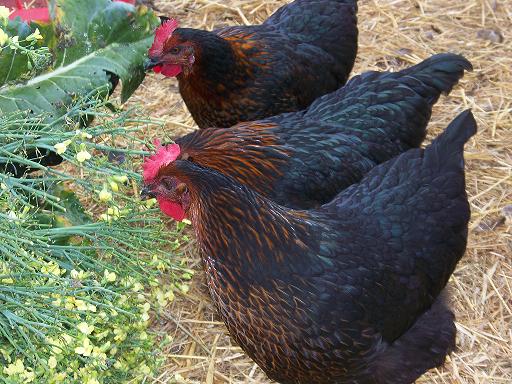
We are into our cloudy, dark season now until spring, so the summer shade cloth is off, and they don’t even mind the light on their nest area. Come spring, the shade cloth will go back on, and a barrier will be put between the nest box and wall to offer some darkness in the nests.
Just a word about supplies purchased here. When we sold eggs, we needed equipment that held up, and was easy to clean. We ordered these items mail order, and have owned, used and abused them for 12 years. None of these cost anymore than the feed store counterparts and still have a lot of life left in them. The feeder is a Kuhl range feeder w/o rain shield, the nest box is a “Kuhl 10-hole with closable perches and removable plastic nest bottoms, and the waterer is a Plasson bell waterer.

The removable bottoms are great for keeping the nest boxes clean, and are actually quite durable. Homemade is great and saves money, but if you have ever had to scoop out some of the stuff that accumulates in nests, you know what I am talking about, broken eggs, chicken crap, add a little heat on a hot summer day, and it’s enough to make you urp right there. This type of nest box would be indispensable too, if you get some kind of pest infestation on your chickens. Pests can hide in every nook and cranny. I can pick up that nest box and carry it outside on my hip, remove the bedding, take out the bottoms and give the entire shebang a deep cleaning. That is impossible to do with a fixed wooden nest box scenario. But, a free ranging chicken lives forever, never craps in the nest or breaks an egg and probably is pest free too, so maybe this last paragraph was a sale’s pitch for free-ranging chickens, I don’t know… .
Chickens go in the nests and …
Set a spell…
I see custard in my future 🙂 Thanks girls!!



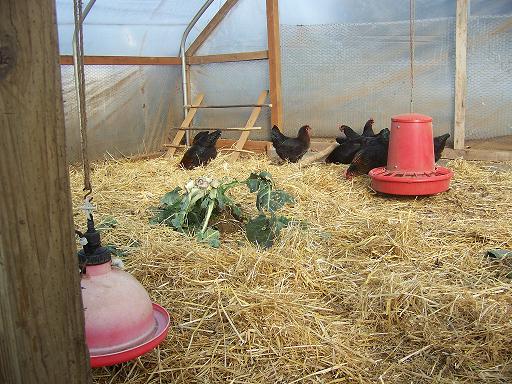
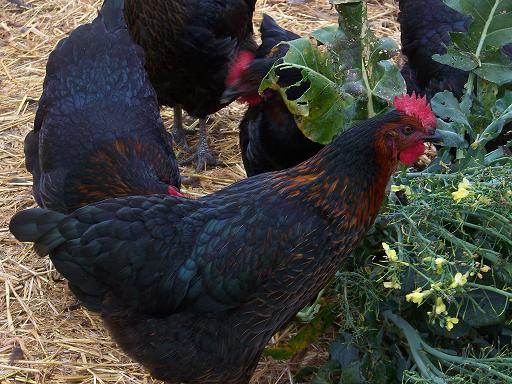

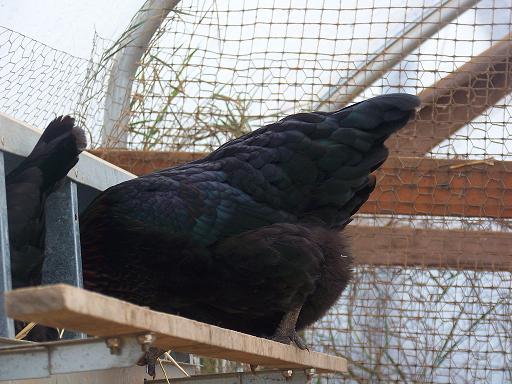
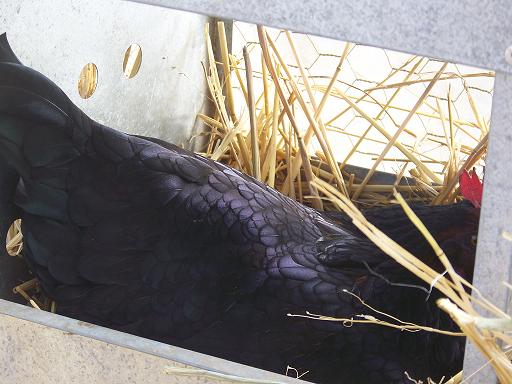
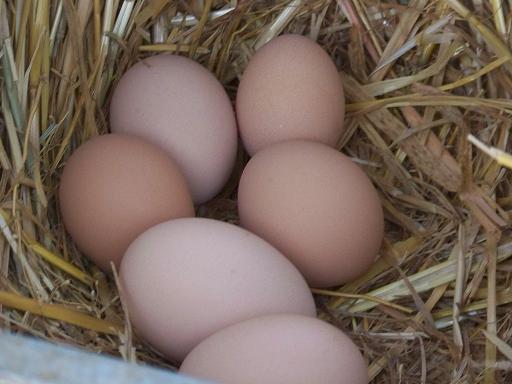


Fantastic post! I don’t know how you do such informative posts all of the time.
I don’t free-range my chickens because I have too many animals around here who would like that. Even with my chickens in a ‘secure pen’ (turned out to be not as secure as I thought), I lost some to a few rogue teenage cats that I ended up relocating to a nearby dairy that is short on barn cats and has a pigeon problem. It was infuriating.
Sarah, I’m glad you read this, I hadn’t forgotten you asked about our chickens, just too many things on the back burner!! P.S. I don’t have three little ones keeping me busy 🙂 Just one big one!!
I guess i’m not clear on the rationale for keeping chickens at all. If chickens are “part of the problem”, then the logical solution would be to keep no chickens.
Basically, from a world hunger point of view, eggs in any quantity are a luxury. The same number of calories to produce a dozen eggs will feed three people.
what people seem to object to most in factory egg situations is that the birds are only given about 1 square foot per bird. Barn eggs don’t seem to be as objectionable to most folks.
We got to confinement farming by walking down the exact path you’re treading. You can produce more product for less labor and cost and lose fewer animals to pests and disease. How do you know when you’ve gone to far? Or is confinement ok? It seems to be, from the post. 5 square feet.
I’m not an activist; i run my own farm, and I’ve finally decided that I need to go to farrowing crates to save my piglets; I lost a litter of 15 pigs yesterday. So this sort of question is one that I’ve been thinking about myself. I’m drawn to the efficiency and the low cost. I’m repelled by the thought.
Bruce, at certain point, the question about keeping chickens or anything for that matter, is why bother when we can go to the store? That is why we quit selling eggs and poultry, because to do that we had to deal too much with people who had unrealistic (mostly chefs)ideals about wanting eggs or fresh broiler chickens year-round, all the while purporting how sustainable they were with their restaurant offerings. Kinda started sticking in the craw. But, because of all the bad press cattle get, when I tell people that my cattle have a better impact on the land and have hardly any carbon usage put in their column, they don’t believe me, and start reciting all the recent studies about CAFO’s. Incidentally, my hens have about 25 square feet per bird. They are fine, and alive. And I agree heartily, poultry of any type should be a luxury. True biodynamic farms have few chickens, only enough to clean up, and keep pests at bay and farms of 100 years ago, did not have many chickens either.
Really though as a farmer, building a greenhouse to help tomatoes to ripen and avoid blight, or a fence to keep out deer, aren’t much different than keeping my chickens safe and productive. The coyotes around here do much to help the eco-system, but I don’t feel like I need to buy feed (chickens) to feed them, or bullets to get rid of them, because I don’t have to do much to keep them from bothering me.
As for the pigs that would be a conundrum – with our cows, culling is an ongoing chore, mostly for mothering abilities. The cow must have a calf each year, unassisted, and she must wean her calf when it is time. Our neighbor had pigs when I was growing up, and he free-ranged his pigs and each sow had a separate A-frame hut that they farrowed in with a creep area for the piglets to get to if they wanted. He never had much trouble, but he kept his own gilts from his best sows, what his criteria was though for selection I couldn’t say.
I thought our area was bad for restrictions, I am thankful I am not trying to farm in your area!
Great post, thanks.
I came to dislike all these “buzz words” like free range because people stretch the meaning so much to make it serve their own purposes. On one hand there are factory farms where they now give chickens few hours of access to 1′ wide dust bowl surrounding the chicken house. On the other a couple of hippie “farmers” I know who just buy chickens and ducks every once in a while and release them on their property, sometimes to never see them again. Both are called free range. Arghhhh……
Leon, I agree, the truth gets stretched a lot when it comes to commercial free-range, or cage-free. When we sold eggs we took in recycled egg cartons, and reused those for CSA’s and private sales. One farm in Washington has about 6 different lines of eggs, all from the same farm. I would be skeptical of spending any money on their eggs, the egg cartons told me more about their farming practices than I wanted to know.
Thanks for this- I am considering raising more chickens for eggs. What varieties do you use and why?
When you’ve gone too far as Bruce asks- I hope this is before we feel we need to make elaborate justifications: when we say “only once” and it becomes the norm, when we squeeze “just a few more” animals in, when we say it would be a fine barn/pasture/pen if only it hadn’t been so wet/gotten so hot or cold/had so many weeds/had x disease.
In short, I think we know when we’ve gone too far. Now “all” we have to do act accordingly.
EJ, When our hens were pastured we stuck with heritage breeds because they are “supposed” to be smarter, which we didn’t find to be true, and there was such a variation between breeds, that they weren’t as productive as claimed. For beauty I liked the Black Australorps, for all around good hens, Barred Rock seemed to fit the bill. However, since we have been keeping them inside, I have used the Golden Sex-links, and because of a hatchery mistake this year I ended up with these Black Sex-links. I gave my 2 year old Goldens to a neighbor, they were still producing at 50 – 60%. I guess it just depends what you want, if you want good mothers, you want a broody hen like a Orpington, if you just want eggs the Sex-Links are great. If worse comes to worst, chickens would not be in my future, so I don’t place a great deal of thought on breeding poultry.
As for going too far, if I was to follow industry standards for loose housing and stuck to the 5 foot rule, I could have 60 hens in my space. That would be horrible, and much too crowded. I think unfortunately these days, confinement has brought about diseases and behaviors that are now accepted as the norm. The info available for help suggests that. It’s common to read dairy blogs where many diseases are so common that the dairy farmers expect it, when it is just a symptom of modern breeding and feeding practices. So when you seek counsel from peers who have the same problems, it sort makes for tunnel vision.
I agree, I think most of us know when we have pushed the limit. But not pushing that limit is the hard part.
What a great, information packed post. My partner and I are considering keeping chickens starting in the spring, and our thoughts have already veered away from purely “free range”. The practical considerations creep in – like keeping the birds safe from predators – and we think it’s more important to do what works for us, rather than attempting to adhere to a predetermined “standard” of some sort. I forwarded this post along to him, as it’s such a wealth of info. Thanks much!
Issa, thanks, it’s always the practicality that rears it’s head. Sometimes too late. With animals it is hard when you make mistakes, the guilt is tremendous. If I drive over a row in the garden with the tractor and squish some carrots, I am disappointed, but if I was to run over a chicken I would feel terrible.
I’m glad you liked the post!
I miss having laying hens around……………..I don’t miss cleaning the hen house. I know I’d do things a bit different now after reading your post. Hanging the water and feed would be one thing.
Thanks for the informative post! We want to get a few chickens for our own egg production. Maybe next spring. We won’t be free-ranging, since our neighborhood has coyotes, foxes, raccoons, dogs, and even a bear sighting every now and then.
By the way, I’ve given you an award! Come on over to check it out.
Very informative. Thank you for a great post. You folks that raise chikens provide us Future Clucker Famers of America a great service!
We raise chickens, and eggs, mostly for ourselves and a friend or two. I don’t advertise. The chickens have a job and one of them is to be my friend. They live in a large home with a huge covered fence yard. They stay inside until two hours before sunset (in the winter) and get out around 4:00 every afternoon in the summer. This gives them time to lay thier eggs so I can find them, and also get out and scratch in the corrals and the fields before bedtime.
It also keeps the predators from becoming sensitive to outside sleeping birds. Although, I did have a fox grab a hen not three feet from me in broad daylight. I tried to grab the fox but I was not fast enough.
We hang the feeder and the waterer, they are given fresh hay for bedding and for thier nests. Their house and nests are kept clean and free from trash.
You have written a very good post!
Linda
http://coloradofarmlife.wordpress.com/
Since Spring, my chickens have been “free-ranging”. Before I finished the coop, something same along and got 3 of my chickens and left one for dead. I quickly finished up the coop and since, knock on wood, no more predator problems. They are loose during the day, we have cats and the dog that are out as well, and so far so good. They don’t seem to stray far, they stay within sight of the coop, and with the exception of 2, the other hens lay their eggs in the coop. One hen lays under the log splitter and another by a tree in the woods.
I’m hoping the orpingtons will hatch some eggs in the spring and give me some new chickens, and once that happens, I’ll have to set up some sort of a pen, to prevent inbreeding.
You feed the chickens coffee grounds? They eat it? Hmmm, I’ll have to try that.
I love your greenhouse coop – so much light and easy to get around in!
We are extremely lucky – we *are* able to free range our hens. We’ve got Livestock Guardian Dogs who keep the predators away and (thankfully) don’t chase chickens, so we can let the chickens out to roam around and clean up the assorted bits of feed that get dropped, eat grasshoppers, and provide entertainment. We do occasionally find that they’re laying eggs in odd places, but most of the time they lay in their nesting boxes and then head outside when they feel like it. The garden is fenced to keep them (and the dogs, and the deer) *out* and I suppose that since they’ve got enough entertainment elsewhere they don’t bother the plants (I’m sure they could get in if they really wanted to).
I do have to make sure I shut the barn in the daytime, or they get in there and make a mess. In the summer we usually have a few who sleep on fence rails, but most head back into their coops at night all by themselves, it seems.
This year, we are trying something new for fall and winter, though – chickens aren’t super bright and they didn’t go into the warm coops and ended up with frozen feet. So, we’ve built a new, warmer coop with and attached it to the garden for an ‘outdoor run’ over the fall/winter months. We have some work to do with the nest boxes, I think, to make them easier to access and to clean – I really like your metal ones, perhaps I’ll add those to my wish list. 🙂 Tomorrow’s mission is to tweak the feeder and waterer layouts.
I agree that the hanging feeder works great – we inherited one from a neighbour and love it. I need to look into a hanging waterer like yours … that’d probably stay cleaner than what we have now.
Great ideas here – even for someone who does let the hens run around loose. 🙂 Thanks!
I live in an area where knowing farmers & finding local produce & groceries is difficult.
The “free range” label is important to me in purchasing eggs for i have been told that many “factory” farms use the “cage free” term but do not have better quality of life for the hens as they still do not go outdoors & are in crowded conditions.
When you live far from where the food is produced it can be a challenge to make good choices. Looks like you’re doing wonderfully with your hens.
But, a free ranging chicken lives forever, never craps in the nest or breaks an egg and probably is pest free too, so maybe this last paragraph was a sale’s pitch for free-ranging chickens, I don’t know… .
Nita…you crack me up!
Like your “labels” post, I don’t really care terms what my food producers use. I know the book definitions of “free range”, “cage-free”, “organic”, “biodynamic”, etc. But I want to see the conditions of the animals for the food I purchase.
The farm in my future runs on a Polyface model, at least initially. I love the concept of chickens “cleaning up” after larger grazers.
But the beauty of what you are doing is that no two farmers have to do it the exact same way as you. There are so many variables, and finding what works for YOU is what makes it sustainable because it’s unlikely you would continue an unworkable system!
Thank you for telling it straight, like you always do. Those chickens all have full tails, and beautiful shiny plumage. They are not pecked or dirty. Their run is clean with plenty of room per hen. Anyone who has a problem with this set-up is too out of touch with reality to waste my time worrying about.
Keep up the great work!
(p.s. Back to PDX next week!)
Thanks for your thoughtful and detailed post. I found it while googling Polyface’s Feathernet system. We keep chickens which we allow to free range, but they’re more of a hobby and a source of eggs for us than a means for profit. I’ve been pondering the balance between letting chickens roam and keeping them safe from predators, so thanks again for the food for thought.
As someone who has a neighbor that just has chickens to have chickens, let me offer my two cents on the free ranging thing. If you own chickens, I think it is your responsibility to keep them safe. I have 20 acres and a dog. I enjoy being able to give my dog freedom and truly delight in watching her patrol my property. She is good about staying on my property under normal circumstances and is quite happy to lounge in her self dug dirt hole, in the sun. However, no dog is perfect and it is a rare dog that can resist the temptation that is free roaming chickens. Because my neighbor insists that his chickens be “free” of any confinement, my dog now has to be tied up all the time. It makes me angry that she and I lose our freedom just so somone’s chickens can roam around where ever they want. Those chickens are also drawing in predators (coyote, fox and badger) that are now setting up their dens on my property. My dog has already been attacked by a fox and my cats have also lost their freedom to go outside at all due to those predators. It represents a risk to my horses as well. I personally hate those chickens! My neighbors don’t even use or sell the eggs, they are just a novelty. signed Miserable Chicken neighbor in Montana